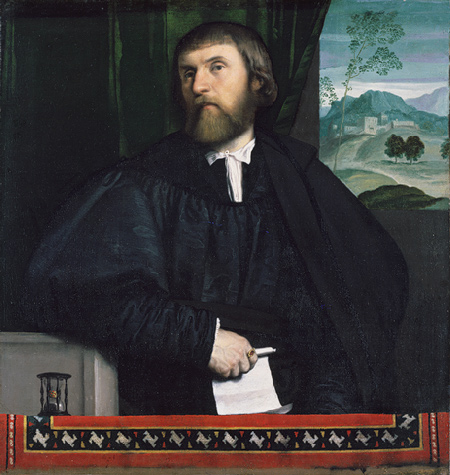
Historical
Oriental Rugs & Carpets
in Medieval European Paintings
Main Page
|
|

Portrait of a Man, ca. 1520–25
Moretto da Brescia (Alessandro Bonvicino) (Italian, Brescian, ca. 1498–1554)
Oil on canvas
34 1/4 x 32 in. (87 x 81.3 cm)
Rogers Fund, 1928 (28.79)
The sitter is unknown, but he must have been a member of one of Brescia's
notable families. A mature work by Moretto, the portrait was done at the time
when he was most drawn to artistic currents in Venice, yet retains certain
conventions of Milanese painting, such as the odd vantage point: everything is
viewed from slightly below eye level. On the other hand, its format—the torso
wide and parallel to the picture plane, the head turned over the shoulder, the
hand wonderfully observed at the lower center of the composition, the curtain
and landscape beyond—all come from Titian. Like Titian as well is the broadly
painted, shimmering silk of the man's clothing. Moretto was also inspired by the
remarkable portraits of the Venetian artist Lorenzo Lotto, whose sitters often
have a rather inward-looking expression, as does this one, and who hold or are
surrounded by objects that have special meaning to them. Here, an hourglass sits
on a carpet-covered ledge, and the man grasps a scrolled sheet of paper, the
blank side of which faces the viewer. The hourglass no doubt alludes to the
passing of time, an allegorical device often employed in sixteenth-century
portraiture, but its precise meaning remains elusive.
Source: Moretto da Brescia (Alessandro Bonvicino) (Italian, Brescian): Portrait
of a Man (28.79) | Heilbrunn Timeline of Art History | The Metropolitan Museum
of Art